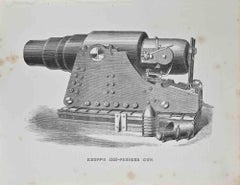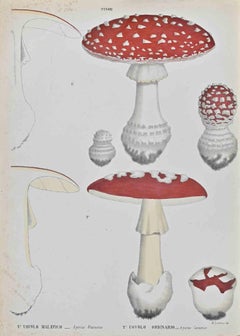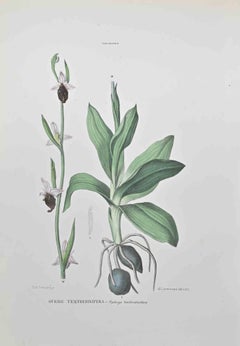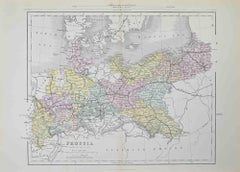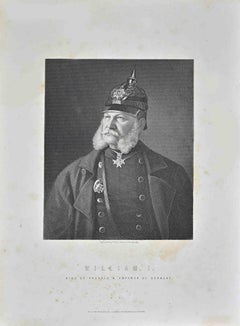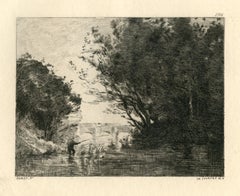1870s Art
to
88
1,191
296
92
45
43
Overall Width
to
Overall Height
to
7,479
21,068
160,095
233,307
1,942
2,228
4,770
6,398
5,825
14,943
20,283
25,509
17,773
13,646
5,305
977
126
59
2
2
1
1
1
1,021
601
5
667
368
358
341
336
293
267
177
173
168
145
89
86
65
65
63
58
56
50
50
515
412
329
301
211
39
13
11
9
8
288
1,116
974
411
Period: 1870s
Krupp's 1000-Pounder Gun - Lithograph - 1872
Located in Roma, IT
Krupp's 1000-Pounder Gun is an artwork realized by an artist during the 19th century.
Lithograph, printed in 1872 by Milliam Mackenzie, London.
Good condition.
Category
Modern 1870s Art
Materials
Lithograph
Ovolo Mushroom - Lithograph by Vincenzo Tenore - 1870s
Located in Roma, IT
Lithograph hand watercolored.
Belongs to the Series "Atlante di Botanica popolare ossia Illustrazione di Piante Notevoli di ogni famiglia" (Atlas of popular botany or illustration o...
Category
Modern 1870s Art
Materials
Lithograph
Ophrys Tenthredinifera - Lithograph by Vincenzo Tenore - 1870s
Located in Roma, IT
Lithograph hand watercolored.
Belongs to the Series "Atlante di Botanica popolare ossia Illustrazione di Piante Notevoli di ogni famiglia" (Atlas of popular botany or illustration o...
Category
Modern 1870s Art
Materials
Lithograph
Prussia (after the war of 1866) - Lithograph - 1872
Located in Roma, IT
Prussia (after the war of 1866) is an artwork realized by an artist during the 19th century.
Lithograph, printed in 1872 by Milliam Mackenzie, London.
Good condition.
Category
Modern 1870s Art
Materials
Lithograph
Portrait of William I King of Prussia and Emperor of ... by William Holl - 1972
Located in Roma, IT
Portrait of William I King of Prussia and Emperor of Germany is an artwork realized by William Holl (1807-1871).
Lithograph, printed in 1872 by Milliam Mackenzie, London.
Good cond...
Category
Modern 1870s Art
Materials
Lithograph
(Le Pecheur) etching
Located in Henderson, NV
Medium: etching (after the painting). Etched by Charles Courtry after the Corot painting. Published in Paris in 1873 by the Galerie Durand-Ruel for the rare "Recueil D'Estampes Grave...
Category
1870s Art
Materials
Etching
Un Coin de Cuisine - Etching by Charles Meryon - 1870s
Located in Roma, IT
Un Coin de Cuisine is an artwork realized by Charles Meryon in the 1870s.
Etching.
Image size:24x31.
Good conditions.
Realized for the "Société des Aquafortistes. Born on the i...
Category
Modern 1870s Art
Materials
Etching
Daphne Mezereum - Lithograph by Vincenzo Tenore - 1870s
Located in Roma, IT
Lithograph hand watercolored.
Belongs to the Series "Atlante di Botanica popolare ossia Illustrazione di Piante Notevoli di ogni famiglia" (Atlas of popular botany or illustration o...
Category
Modern 1870s Art
Materials
Lithograph
Organography - Lithograph by Vincenzo Tenore - 1870s
Located in Roma, IT
Lithograph.
Plate from "Atlante di Botanica popolare ossia Illustrazione di Piante Notevoli di ogni famiglia" (Atlas of popular botany or illustration of notable plants of each fami...
Category
Modern 1870s Art
Materials
Lithograph
"Le matin environs de Tervueren" etching
Located in Henderson, NV
Medium: etching (etched by Theophile Narcisse Chauvel after the Hippolyte Boulanger painting). Published in Paris by L'Art in 1875 and printed by Francois Lienard on laid paper. The ...
Category
1870s Art
Materials
Etching
Antique Dog Lithograph, Taste of Alfred De Dreux, France circa 1870 Greyhounds D
By Alfred de Dreux
Located in SANTA FE, NM
Antique Dog Portrait
Lithograph in the Taste of Alfred De Dreux
Greyhounds D
France, circa 1870
Lithography
25 5/8 x 19 5/8 (28 x 20 frame) inc...
Category
Romantic 1870s Art
Materials
Lithograph
William Ridley - Etching by William Ridley - 1870s
Located in Roma, IT
Draham Harbour is an artwork realized by William Ridley in the 1870s.
Etching.
Good conditions.
Realized for the "Société des Aquafortistes. Born on the initiative of the publish...
Category
Modern 1870s Art
Materials
Etching
Battle of Sedan - Lithograph by Robert Walker - 1872
Located in Roma, IT
Battle of Sedan is an artwork realized by R. Walker.
Lithograph, printed in 1872 by Milliam Mackenzie, London.
Good condition.
Category
Modern 1870s Art
Materials
Lithograph
The Harbour, Sailboats - Original etching - Ed. Durand Ruel, 1873
Located in Paris, IDF
Edouard MANET (after)
The Harbour, Sailboats, 1873
Original Etching
Engraved by Gaucherel under the supervision of MANET
Printed signature in the plate
On laid paper 20,5 x 30 cm (c. 8 x 12 in)
INFORMATION : This etchings was edited in 1873 by Galerie Durand Ruel...
Category
Impressionist 1870s Art
Materials
Etching
The Bucaneva - Lithograph by Vincenzo Tenore - 1870s
Located in Roma, IT
Lithograph hand watercolored.
Belongs to the Series "Atlante di Botanica popolare ossia Illustrazione di Piante Notevoli di ogni famiglia" (Atlas of popular botany or illustration o...
Category
Modern 1870s Art
Materials
Lithograph
Australian Myrtle - Lithograph by Vincenzo Tenore - 1870s
Located in Roma, IT
Lithograph hand watercolored.
Belongs to the Series "Atlante di Botanica popolare ossia Illustrazione di Piante Notevoli di ogni famiglia" (Atlas of popular botany or illustration o...
Category
Modern 1870s Art
Materials
Lithograph
Yellow-flowered Nelumbia - Lithograph by Vincenzo Tenore - 1870s
Located in Roma, IT
Lithograph hand watercolored.
Belongs to the Series "Atlante di Botanica popolare ossia Illustrazione di Piante Notevoli di ogni famiglia" (Atlas of popular botany or illustration o...
Category
Modern 1870s Art
Materials
Lithograph
Portrait of Prince Frederick Charles - Lithograph by William Holl - 1872
Located in Roma, IT
Portrait of Prince Frederick Charles is an artwork realized by William Holl (1807-1871), from a Photograph.
Lithograph, printed in 1872 by Milliam Mackenzie, London.
Good condition.
Category
Modern 1870s Art
Materials
Lithograph
Paris, Vue Prise du Pont St Michel - Etching by Maxime Lalanne - 1870s
Located in Roma, IT
Vue Prise du Pont St Michel is an artwork realized by Maxime Lalanne in the 1870s.
Etching.
Image size:22x29
Good conditions.
Realized for the "Société des Aquafortistes. Born ...
Category
Modern 1870s Art
Materials
Etching
Small Hemlock - Lithograph by Vincenzo Tenore - 1870s
Located in Roma, IT
Lithograph hand watercolored.
Belongs to the Series "Atlante di Botanica popolare ossia Illustrazione di Piante Notevoli di ogni famiglia" (Atlas of popular botany or illustration o...
Category
Modern 1870s Art
Materials
Lithograph
Academic master drawing: Allegorical Scene artist in Musée d'Orsay
Located in Norwich, GB
A fascinating allegorical scene by French master Paul-Louis Delance (1848–1924), an artist known for the allegorical and history paintings. His grandfather was the Count Joseph van R...
Category
Academic 1870s Art
Materials
Charcoal, Paper
France in Departments - Lithograph - 1872
Located in Roma, IT
France in Departments is an artwork realized by an artist of the 19th century.
Lithograph, printed in 1872 by Milliam Mackenzie, London.
Good condition.
Category
Modern 1870s Art
Materials
Lithograph
Salvador Murillo "Solitary Figure on a Road" - Framed Antique Landscape Painting
By Salvador Murillo
Located in New Orleans, LA
I actually prefer this painting to the very slightly larger one by Murillo that sold for $11,600 at auction (Hargesheimer & Günther) in 2009. Another couple of paintings sold at auct...
Category
Realist 1870s Art
Materials
Oil
"L'Incendie" original etching
Located in Henderson, NV
Medium: original etching. This is a rich, dark impression on laid paper with full original margins, printed by A. Salmon and published in Paris by L'Art in 1876. Size: 9 1/2 x 10 7/8...
Category
1870s Art
Materials
Etching
Rue du Rivage - Etching by Armand Queyroy - 1870s
Located in Roma, IT
Rue du Rivage is an artwork realized by A.Queyroy in the 1870s.
Etching.
Image size: 26x21
Good conditions.
Realized for the "Société des Aquafortistes. Born on the initiative ...
Category
Modern 1870s Art
Materials
Etching
"Vaine Pature" etching
Located in Henderson, NV
Medium: etching (etched by Theophile Narcisse Chauvel after the Jacomin painting). This impression on japon paper was printed by Francois Lienard in 1875 (before letters were added) ...
Category
1870s Art
Materials
Etching
Contemplation
Located in Middletown, NY
This is an engaging work with masterful detail that will unfold for an intent viewer, particularly in the area of the figure's well-worn hands, and her traditional clothing. The image depicts a Bavarian woman deep in thought while winding a skein of wool. She is seated outside of her home, where she has brought her yarn swift...
Category
English School 1870s Art
Materials
Watercolor, Handmade Paper
Black Mustard - Lithograph by Vincenzo Tenore - 1870s
Located in Roma, IT
Lithograph hand watercolored.
Belongs to the Series "Atlante di Botanica popolare ossia Illustrazione di Piante Notevoli di ogni famiglia" (Atlas of popular botany or illustration o...
Category
Modern 1870s Art
Materials
Lithograph
Battle of Courcelles - Lithograph by R. Walker - 1872
Located in Roma, IT
Battle of Courcelles is a map realized by R. Walker.
Lithograph, printed in 1872 by Milliam Mackenzie, London.
Good condition.
Category
Modern 1870s Art
Materials
Lithograph
Le Haut d'Un Battant de Porte - Etching by Félix Bracquemond - 1870s
Located in Roma, IT
Le Haut d'Un Battant de Porte is an artwork realized by Félix Bracquemond in the 1870s.
Etching.
image size: 28x38
Good conditions.
Realized for the "Société des Aquafortistes. ...
Category
Modern 1870s Art
Materials
Etching
Les Demoiselles de Village - Etching by Gustave Courbet - 1870s
Located in Roma, IT
Les Demoiselles de Village is an artwork realized by Gustave Courbet in the 1870s.
Etching.
Good conditions.
Realized for the "Société des Aquafortistes. Born on the initiative o...
Category
Modern 1870s Art
Materials
Etching
Polish Swan - Woodcut Print by Alexander Francis Lydon - 1870
Located in Roma, IT
Polish Swan is a modern artwork realized in 1870 by the British artist Alexander Francis Lydon (1836-1917) .
Woodcut print on ivory-colored paper.
Hand-colored, published by Londo...
Category
Modern 1870s Art
Materials
Woodcut
Ostreate Agaric - Lithograph by Vincenzo Tenore - 1870s
Located in Roma, IT
Lithograph hand watercolored.
Belongs to the Series "Atlante di Botanica popolare ossia Illustrazione di Piante Notevoli di ogni famiglia" (Atlas of popular botany or illustration o...
Category
Modern 1870s Art
Materials
Lithograph
"Un Grain à Trouville" (Squall at Trouville) from L'Illustration Nouvelle
Located in Soquel, CA
"Un Grain à Trouville" (Squall at Trouville) from L'Illustration Nouvelle
Dramatic etching of an approaching storm by Félix Hilaire Buhot (French,...
Category
Barbizon School 1870s Art
Materials
Laid Paper, Etching, Aquatint
The Lobeliaceae - Lithograph by Vincenzo Tenore - 1870s
Located in Roma, IT
Lithograph hand watercolored.
Plate from "Atlante di Botanica popolare ossia Illustrazione di Piante Notevoli di ogni famiglia" (Atlas of popular botany or illustration of notable p...
Category
Modern 1870s Art
Materials
Lithograph
Yew Tree - Lithograph by Vincenzo Tenore - 1870s
Located in Roma, IT
Lithograph hand watercolored.
Belongs to the Series "Atlante di Botanica popolare ossia Illustrazione di Piante Notevoli di ogni famiglia" (Atlas of popular botany or illustration o...
Category
Modern 1870s Art
Materials
Lithograph
Pyrenean Pine - Lithograph by Vincenzo Tenore - 1870s
Located in Roma, IT
Lithograph hand watercolored.
Belongs to the Series "Atlante di Botanica popolare ossia Illustrazione di Piante Notevoli di ogni famiglia" (Atlas of popular botany or illustration o...
Category
Modern 1870s Art
Materials
Lithograph
The Tea Rose - Lithograph by Vincenzo Tenore - 1870s
Located in Roma, IT
Lithograph hand watercolored.
Plate from "Atlante di Botanica popolare ossia Illustrazione di Piante Notevoli di ogni famiglia" (Atlas of popular botany or illustration of notable p...
Category
Modern 1870s Art
Materials
Lithograph
Nature Morte - Etching by Leon Gaucherel - 1860s
Located in Roma, IT
Nature Morte is an artwork realized by Leon Gaucherel in the 1870s.
Etching.
Image size: 31 x 19
Good condition.
Realized for the "Société des Aquafortistes. Born on the initi...
Category
Modern 1870s Art
Materials
Etching
Antique Dog Lithograph, Taste of Alfred De Dreux, France circa 1870 Wolfhound E
By Alfred de Dreux
Located in SANTA FE, NM
Antique Dog Portrait
Lithograph in the Taste of Alfred De Dreux
Wolfhound E
France, circa 1870
Lithography
25 5/8 x 19 5/8 (28 x 20 frame) inches
Six lithographs of dog portraits....
Category
Romantic 1870s Art
Materials
Lithograph
Sarracenia Porporina - Lithograph by Vincenzo Tenore - 1870s
Located in Roma, IT
Lithograph hand watercolored.
Plate from "Atlante di Botanica popolare ossia Illustrazione di Piante Notevoli di ogni famiglia" (Atlas of popular botany or illustration of notable p...
Category
Modern 1870s Art
Materials
Lithograph
The French Landscape - Original Lithograph by Louise de Rohan-Chabot - 1878
Located in Roma, IT
The french Landscape is an original Lithograph realized by Louise de Rohan-Chabot in 1878.
Good conditions except for some foxings.
Signed and dated lower left, 1878.
The artwork ...
Category
Modern 1870s Art
Materials
Lithograph
Amadee, Heliogravure by Marcantonio Raimondi
By Marcantonio Raimondi
Located in Long Island City, NY
Marcantonio Raimondi, After by Amand Durand, Italian (1480 - 1534) - Amadee, Year: 1875, Medium: Heliogravure, Size: 4.5 x 4.5 in. (11.43 x 11.43 cm), Printer: Amand Durand, Descr...
Category
Old Masters 1870s Art
Materials
Etching
Japanese Medlar - Lithograph by Vincenzo Tenore - 1870s
Located in Roma, IT
Lithograph hand watercolored.
Belongs to the Series "Atlante di Botanica popolare ossia Illustrazione di Piante Notevoli di ogni famiglia" (Atlas of popular botany or illustration o...
Category
Modern 1870s Art
Materials
Lithograph
Presée - Etching by François Chifflart - 1870s
Located in Roma, IT
Presée is an artwork realized by F. Cifflart in the 1870s.
Etching.
Good conditions.
Realized for the "Société des Aquafortistes. Born on the initiative of the publisher Alfred Ca...
Category
Modern 1870s Art
Materials
Etching
The Artocapeae - Lithograph by Vincenzo Tenore - 1870s
Located in Roma, IT
Lithograph hand watercolored.
Plate from "Atlante di Botanica popolare ossia Illustrazione di Piante Notevoli di ogni famiglia" (Atlas of popular botany or illustration of notable p...
Category
Modern 1870s Art
Materials
Lithograph
Battle of Woerth - Lithograph - 1872
Located in Roma, IT
Battle of Woerth is an artwork realized by R. Walker.
Lithograph, printed in 1872 by Milliam Mackenzie, London.
Good condition.
Category
Modern 1870s Art
Materials
Lithograph
“The Afternoon Walker by the Pond”
Located in Warren, NJ
Original watercolor on paper
signed and dated 1874 to lower left
Provenance
purchased from Kennedy Galleries, NY
The Collection of Bruce and Barbara Sullivan, Birmingham, Alabama
...
Category
1870s Art
Materials
Watercolor
Hemlock - Lithograph by Vincenzo Tenore - 1870s
Located in Roma, IT
Lithograph hand watercolored.
Belongs to the Series "Atlante di Botanica popolare ossia Illustrazione di Piante Notevoli di ogni famiglia" (Atlas of popular botany or illustration o...
Category
Modern 1870s Art
Materials
Lithograph
Black Pepper - Lithograph by Vincenzo Tenore - 1870s
Located in Roma, IT
Lithograph hand watercolored.
Belongs to the Series "Atlante di Botanica popolare ossia Illustrazione di Piante Notevoli di ogni famiglia" (Atlas of popular botany or illustration o...
Category
Modern 1870s Art
Materials
Lithograph
19th Century Child and Dog Portrait
Located in San Francisco, CA
Fabulous 19th Century oil on canvas portrait of a child with their dog. It is signed and dated 1872 underneath the gold matting. I cannot decipher the signature. Painting could be ei...
Category
Realist 1870s Art
Materials
Oil
Little Owl - Woodcut Print by Alexander Francis Lydon - 1870
Located in Roma, IT
Little Owl is a modern artwork realized in 1870 by the British artist Alexander Francis Lydon (1836-1917).
Woodcut print on ivory-colored paper.
Hand-colo...
Category
Modern 1870s Art
Materials
Woodcut
Organography - Lithograph by Vincenzo Tenore - 1870s
Located in Roma, IT
Lithograph.
Plate from "Atlante di Botanica popolare ossia Illustrazione di Piante Notevoli di ogni famiglia" (Atlas of popular botany or illustration of notable plants of each fami...
Category
Modern 1870s Art
Materials
Lithograph
Ruins of the Ancient Aqueducts by Carl Friedrich Heinrich Werner - 1872
Located in Roma, IT
Ruins of the Ancient Aqueducts is an original artwork realized by Carl Friedrich Heinrich Werner (Weimar, 4 October 1808 – Leipzig, 10 January 1894) in 1872.
Watercolour and pencil on paper.
Hand-signed and dated on the lower left corner: C. Werner 1872.
Good conditions. Prov. Collection Dr. Peter Nicolaus (1940-2020).
Carl Friedrich Heinrich Werner (4 October 1808 – 10 January 1894) was a German...
Category
Modern 1870s Art
Materials
Watercolor, Pencil
The Olaceae - Lithograph by Vincenzo Tenore - 1870s
Located in Roma, IT
Lithograph hand watercolored.
Plate from "Atlante di Botanica popolare ossia Illustrazione di Piante Notevoli di ogni famiglia" (Atlas of popular botany or illustration of notable p...
Category
Modern 1870s Art
Materials
Lithograph
Vue du Port au Chemin de Fer à Honfleur - Etching by Johan B. Jongkind - 1870s
Located in Roma, IT
Vue du Port au Chemin de Fer à Honfleur is an artwork realized by Jongkind in the 1870s.
Etching.
Good conditions.
Realized for the "Société des Aquafortistes. Born on the initi...
Category
Modern 1870s Art
Materials
Etching
The Abietinee - Lithograph by Vincenzo Tenore - 1870s
Located in Roma, IT
Lithograph hand watercolored.
Plate from "Atlante di Botanica popolare ossia Illustrazione di Piante Notevoli di ogni famiglia" (Atlas of popular botany or illustration of notable p...
Category
Modern 1870s Art
Materials
Lithograph
“Flowers in Classical Urn”
Located in Southampton, NY
Very fine example of the artistry of the master still life painter of his day, Edward Chalmers Leavitt. Signed lower left and dated 1875. Condition is very good. Provenance: Christie’s Auction, New York, December 2, 1992, lot 228. Overall in period replica gold leaf deep cove gallery frame 25.75 by 17.75 inches.
Edward C. Leavitt (1842-1904) worked in Providence but is also associated with the Fall River School of still life painting through the influence of, and affinity of his style to, the work of Robert S. Dunning. Leavitt was a student of landscape painter James Morgan Lewin, a founder of Providence’s artistic “group of 1855.” Leavitt’s work is known for its realism, rich coloration, sharp focus and careful finish. His paintings of fruit and flowers incorporate ornate decorative pieces such as silver or bronze ewers, salvers, tankards, or plates on carved and polished tables. Leavitt was a prolific artist, exhibiting frequently at the National Academy of Design, the Boston Art Club, and the Pennsylvania Academy of Fine Arts. His work inspired other still life painters in Providence, resulting in that city’s own still life tradition, including artists such as John Clinton Spencer, Bryant Chapin...
Category
Academic 1870s Art
Materials
Canvas, Oil
$3,600 Sale Price
33% Off
Portrait de Paul Gauguin - Woodcut by Georges-Daniel DeMonfried - 1900s
Located in Roma, IT
Hand signed and numbered with pencil and china ink. Edition of 100 prints.
Fine print with sheet in perfect conditions, on simili-japon. Full margins.
Category
Modern 1870s Art
Materials
Woodcut
Aniso of Sila - Lithograph by Vincenzo Tenore - 1870s
Located in Roma, IT
Lithograph hand watercolored.
Belongs to the Series "Atlante di Botanica popolare ossia Illustrazione di Piante Notevoli di ogni famiglia" (Atlas of popular botany or illustration o...
Category
Modern 1870s Art
Materials
Lithograph
